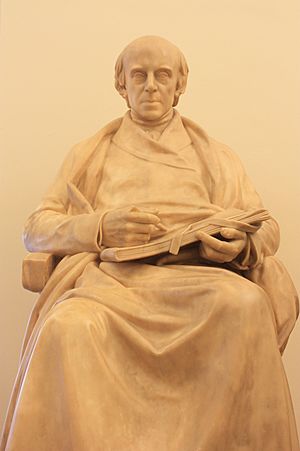Musgrave Watson facts for kids

Musgrave Lewthwaite Watson (born January 24, 1804 – died October 28, 1847) was a talented English sculptor from the early 1800s. He created many important statues and carvings, including parts of Nelson's Column in London.
Life Story
Musgrave Watson was born in Cumberland, England, in 1804. His family were successful farmers who also owned a metal workshop. From a young age, Musgrave wanted to be an artist. However, his parents wanted him to have a different career. In 1821, he began training to become a lawyer in Carlisle.
After his father passed away in 1823, Musgrave decided to follow his dream. He left his law studies and moved to London to learn sculpture. He received advice from the famous sculptor John Flaxman. Musgrave also studied at the Royal Academy of Arts, a well-known art school.
In 1825, he traveled to Rome, Italy, to continue his studies. When he returned in 1828, he wanted to open his own sculpture studio. But he faced money problems. This meant he had to work for other famous sculptors like Sir Francis Chantrey and Richard Westmacott.
Later, he spent two years working at the Coade Artificial Stone Works in Lambeth. Here, he made sculptures and decorative carvings for buildings. This job paid well, but he still wanted to have his own studio. So, he left and tried to set up his own business again.
Musgrave had more financial difficulties. But things started to get better. In 1842, he finished a large stone carving for Edward Moxhay's Commercial Hall in London. This carving was about 5.5 feet tall and 73 feet long. It received great praise from art critics. Today, you can see this impressive carving in Napier Terrace, Islington.
In the same year, he received a big job from Lord Eldon. He was asked to create a marble sculpture of Lord Eldon's grandfather and great-uncle. This important project had originally been given to Sir Francis Chantrey, but he died before he could start it.
In 1839, Watson entered two design competitions for the Nelson's Column monument in Trafalgar Square. He didn't win the main prize. However, he was later chosen to sculpt a special panel for the column's base. This panel shows the famous Battle of Cape St. Vincent.
Musgrave was not entirely happy with the terms of this job. He wrote in a letter that he thought the public might be disappointed with the carvings. He felt the battle scenes were not ideal for sculpture. Musgrave Watson suffered from a heart condition for most of his adult life. He passed away in 1847 before he could finish the Cape St Vincent carving. He also left the Eldon sculpture and a statue of John Flaxman for others to complete. Before he died, he had most of the models in his studio destroyed.
Famous Works
Here are some of Musgrave Watson's important sculptures:
- A double portrait of brothers Lord Eldon and Lord Stowell at University College, Oxford (finished in 1842).
- A statue of Queen Elizabeth I for the Royal Exchange, London (finished in 1844).
- Marble statues of Major Francis Aglionby, a Member of Parliament, and Lord Lonsdale in Carlisle (finished in 1843 and 1845).
- A statue of John Flaxman for University College London (finished in 1847).
- Pedimental sculpture (a triangular carving above a doorway) for the Victoria Rooms in Bristol.
- The large frieze (a long, narrow carving) from Moxhall's Hall of Commerce in the City of London. This carving was moved to Napier Terrace Islington in 1975.


